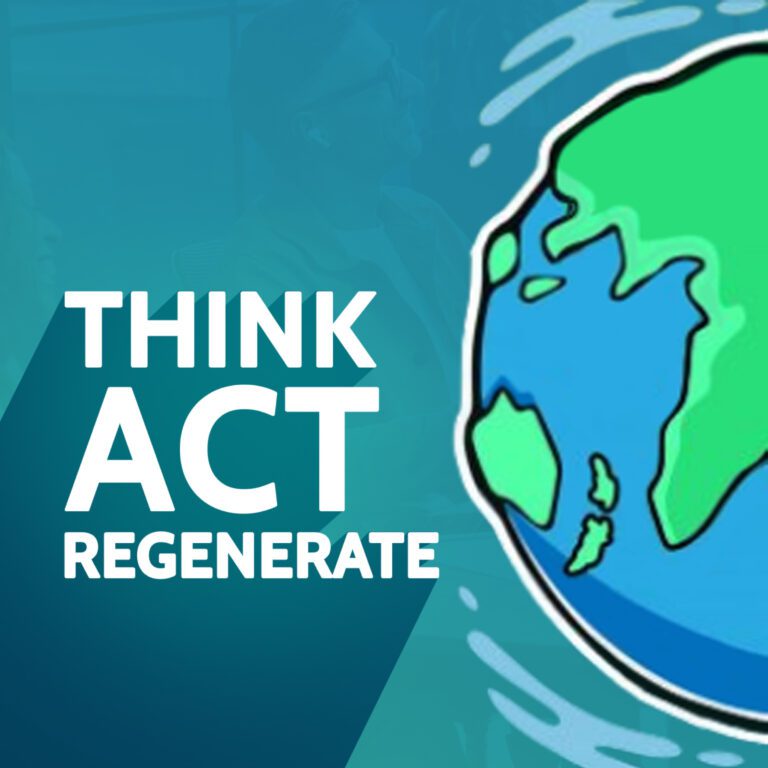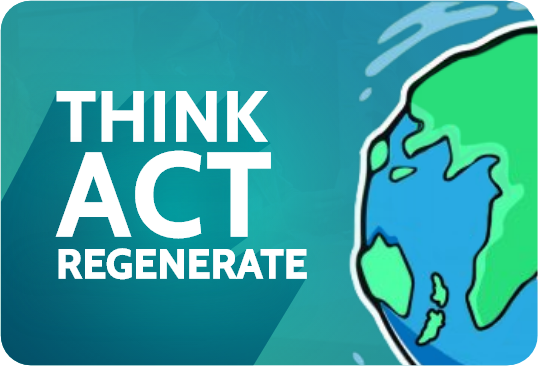
THINK ACT REGENERATE is a podcast by Leigh Baker of ThinkActRegenerate which explores the wealth of regenerative design solutions happening on the ground in Australia and New Zealand, as well as around the world.
This podcast episode summarises the third of the Think Act Regenerate INSIGHTS email series on regenerative innovation -and the rich smorgasbord of business and career opportunities it offers.
Circular Economy principles have been a driver of regenerative business growth over the last 1-2 decades – and proving increasingly profitable. A lot of people have heard the term – but think of it as “something about better recycling”.
However, assuming that the circular economy is just about better recycling is like assuming that all you can do with a smartphone is make voice calls – because it’s called a phone.
This podcast episode explores the full scope of Circular Economy design, with examples from over two decades of real world business innovation.
CREDITS
Original music composed for the show by Ian Hopkinson of HopkinsonCreative.com – used with permission.
LINKS
General resources
The Australian Circular Economy Hub: https://acehub.org.au/
The Ellen Macarthur Foundation’s Case Studies and Examples: https://www.ellenmacarthurfoundation.org/topics/circular-economy-introduction/examples
The Ellen Macarthur Foundation’s CIRCULAR DESIGN GUIDE: https://www.ellenmacarthurfoundation.org/circular-design-guide/overview
The full Think Act Regenerate INSIGHTS email series: https://thinkactregenerate.com/insights/
Examples
Bananas – from food waste to food in Australia: https://thinkactregenerate.com/dried-bananas-food-vodka/
Banoffee Leather: https://banofileather.com/
Bateup Green Chair: https://www.bateupconsulting.com.au/greenchair
Canyon Solar in supermarket carparks: https://onestepoffthegrid.com.au/solar-carparks-offer-renewable-solution-for-supermarkets-and-cheap-ev-charging/
Caterpillar remanufacturing: https://www.caterpillar.com/en/company/sustainability/remanufacturing.html
Close the Loop (R) Australia: https://www.closetheloop.com.au/about-us/
Close the Loop® road surfacing:
https://www.closetheloop.com.au/tonerplas-in-the-award-winning-m80-ring-road-upgrade/
https://roadsonline.com.au/from-plastic-to-pavement-with-close-the-loop/
EU Unsold Clothing Destruction Ban: https://english.aawsat.com/fashion/4711286-eu-approves-ban-destruction-unsold-clothing
Framework Computers: https://frame.work/au/en
Interface early years BUSINESS LESSONS FROM A RADICAL INDUSTRIALIST: https://us.macmillan.com/books/9781429997164/businesslessonsfromaradicalindustrialist
Interface reuse and upcycling: https://www.caterpillar.com/en/company/sustainability/remanufacturing.html
Kua Coffee: https://kuacoffee.co/about
Rohner upholstery textiles: https://www.wipo.int/wipo_magazine/en/2007/02/article_0002.html

This podcast episode summarises the third of the Think Act Regenerate INSIGHTS email series on regenerative innovation – and the rich smorgasbord of business and career opportunities it offers.
Circular Economy principles have been a driver of regenerative business growth over the last 1-2 decades. A lot of people have heard the term – but typically think of it as “something about better recycling”.
However, assuming that the circular economy is just about better recycling is like assuming that all you can do with a smartphone is make voice calls – because it’s called a phone.
This episode explores the full scope of Circular Economy design, with examples from over two decades of real world business innovation.
LINKS
General resources
Australian Circular Economy Hub: https://acehub.org.au/
Blue Ocean Strategy: https://www.blueoceanstrategy.com/blog/7-powerful-blue-ocean-strategy-examples/
Business Model Canvas: https://en.wikipedia.org/wiki/Business_Model_Canvas
Ellen Macarthur Foundation’s Case Studies and Examples: https://www.ellenmacarthurfoundation.org/topics/circular-economy-introduction/examples
Ellen Macarthur Foundation’s CIRCULAR DESIGN GUIDE: https://www.ellenmacarthurfoundation.org/circular-design-guide/overview
Think Act Regenerate INSIGHTS email series: https://thinkactregenerate.com/insights/
Examples
Bananas – from food waste to food in Australia: https://thinkactregenerate.com/dried-bananas-food-vodka/
Banoffee Leather: https://banofileather.com/
Bateup Green Chair: https://www.bateupconsulting.com.au/greenchair
Canyon Solar in supermarket carparks: https://onestepoffthegrid.com.au/solar-carparks-offer-renewable-solution-for-supermarkets-and-cheap-ev-charging/
Caterpillar remanufacturing: https://www.caterpillar.com/en/company/sustainability/remanufacturing.html
Close the Loop (R) Australia: https://www.closetheloop.com.au/about-us/
Close the Loop® road surfacing:
https://www.closetheloop.com.au/tonerplas-in-the-award-winning-m80-ring-road-upgrade/
https://roadsonline.com.au/from-plastic-to-pavement-with-close-the-loop/
EU Unsold Clothing Destruction Ban: https://english.aawsat.com/fashion/4711286-eu-approves-ban-destruction-unsold-clothing
Framework Computers: https://frame.work/au/en
Interface early years BUSINESS LESSONS FROM A RADICAL INDUSTRIALIST: https://us.macmillan.com/books/9781429997164/businesslessonsfromaradicalindustrialist
Interface reuse and upcycling: https://www.caterpillar.com/en/company/sustainability/remanufacturing.html
Kua Coffee: https://kuacoffee.co/about
Rohner upholstery textiles: https://www.wipo.int/wipo_magazine/en/2007/02/article_0002.html
CREDITS
Original music composed for the show by Ian Hopkinson of HopkinsonCreative.com – used with permission.
TRANSCRIPT
Hello there. I’m Leigh Baker your host for this episode of the think act regenerate podcast, where we explore the myriad ways that thinking more broadly about today’s challenges is enabling deeper, more informed actions today and delivering smarter solutions today.
This podcast episode was recorded on Wurrundjeri lands near Naarm, Melbourne Australia.
Each of these insights is simply a perspective that you can use to explore for your best business career and innovation opportunities.
In this and several coming episodes I’m exploring some key mind set shifts that I’ve seen evolving in the world of business innovation over the last two decades. I call these shifts INSIGHTS – because insight is what I’ve developed as I’ve worked with them.
Not every insight will apply to every business or every career. However, they’re a useful tool to side-step the “everybody knows” thinking that’s presented to us every day.
***
These insights started life as a package back in 2009, when I distilled my first seven years of regenerative business explorations into a small friendly 90 page book called the deep green profit handbook.
Rather than do further editions of a physical book in a rapidly changing world. I went on to convert the content into a short, free email series, with each email explaining one of the 10 insights that I find most useful in exploring regenerative thinking and its applications in the real world. (There’s a link to the think at regenerate insights email series in the show notes.)
I’ve started summarising those 10 insight emails into episodes on this podcast. This is the third episode discussing circular systems design and implementation.
The first episode explored the shift from expensive obligation thinking to OPPORTUNITY thinking.
The second insight is about beginning with the end in mind and intentionally designing REGENERATION into our systems from the ground up – developing products, services, and systems that deliver economic value BY restoring and regenerating their host ecosystems and communities.
[00:03:00]
You can listen into past episodes if you want to get caught up – or you can subscribe to the email series.
For the remainder of these insight episodes. I’ll be talking about firstly the four key supply chain shifts, and then four implementation trends that I’ve observed being used to deploy regenerative design and regenerative business into the real world today.
In today’s episode, we’re exploring the game of full spectrum circular economy innovation.
The term circular economy is getting a lot more traction on the media than it used to 10 years ago. However it mostly gets presented with ” recycling problems” in a lot of stories and conversations. And that means – by association – that many of the fundamental shifts in design thinking it involves often get missed, because everybody thinks it’s just about recycling.
So people don’t see the full spectrum of opportunities that circular systems open for innovators who think long-term. Let’s dive in to circular systems.
***
Since the industrial revolution (and probably a bit longer if you look at prehistoric middens) the way that humans have thought about making products and services we use has been a bit “one way”.
What do we do to make our stuff? Increasingly today, we dig materials up and use lots of resources to refine them and then take those materials and use them to make a product or to deliver a service. And that’s typically done in processes powered by burning a non-renewable fuel.
Along the way in our manufacturing process, we call the byproducts “waste”. And mostly dump them into the ecosystems that deliver our food, water, air, and weather.
Then we sell the product to consumers – who will use it for a while and then dump the product in (surprise, surprise) a “waste bin” when they’re finished with it. It’s a loop we’ve been repeating for centuries.
Today it’s increasingly apparent – in a growing list of issues from ocean plastics, to forest destruction – that the human species operates inside finite, quite fragile ecosystems.
There’s increasing evidence that the 20 kilometer layer of land, ocean and atmosphere we call “the biosphere” isn’t an infinite source of resources that we can extract from forever. Nor does it deliver infinite waste disposal and unlimited toxin processing capacity.
Fortunately, the world’s innovators and entrepreneurial thinkers have been bringing design solutions to market in recent decades under names such as Circular Economy and Cradle to Cradle Product Innovation and Biomimicry and Doughnut Economics.
[00:06:00]
And today these cleaner, smarter, safer, and more efficient approaches to product service and system design have developed to a point where they increasingly offer substantial commercial innovation opportunities to forward thinking entrepreneurial organisations of all sizes.
Circular Economy is about MUCH more than recycling
As I said in the intro, a lot of people have heard about circular economy – but not so many are across the full spectrum of business innovation opportunities that it offers. It’s often seen as just the latest recycling fad – some new attempt to jazz up and re-brand a tired, old waste processing system.
However, assuming circular economy innovation is merely about better recycling is like assuming that all you can do with a smartphone is make voice calls because it’s called a phone…
Sure you can make voice calls on your smartphone – and you can do a whole lot more from reading an ebook to paying for your coffee.
It’s the same with circular economy.
Yes, recycling old products (or ideally upcycling them into high value materials) is part of circular systems. But it also involves next generation product design – and systems innovation- and smarter business models.
Full spectrum circular economy IS about recycling AND it’s also about challenging the validity of the very idea of waste. Because there is no magical away that’s safe to dump it. And given the huge amount of valuable resource it takes to generate “waste”, maybe we can do better than antiquated burn, bury and drown approaches?
We can.
Like Indian banana farmers turning their plant waste into an alternative vegan leather product. Or a couple of Australian banana farmers turning their on-farm, off-spec green bananas into nutrient rich, gluten-free flour.
Circular design strategies also put a focus on refurbishing and remanufacturing. Particularly around long life products, so that we get maximum value out of the resources that went into those products.
So today we have global manufacturer Caterpillar – refurbishing and remanufacturing their old heavy equipment to give it a new life. And AMP – recycling a whole skyscraper to increase its floor space, its comfort and its environmental performance so they increase their income while they reduce their construction costs.
[00:09:00]
Circular design strategies include repair and repairability. So today we have Framework computers who make and sell user- repairable and upgradable notebook computers. And even publish DIY repair guides on their websites, as well as designing and developing plug-and-play multiuse components and modules. So computers are user configurable as well as user repairable.
Another circular strategy is managing the reuse of still viable products.
Over in Perth Bateup Consulting has a Green Chair office furniture reuse program.
They divert good office furniture from landfill after business refurbishments, capturing that furniture and redirecting it so it can be used by resource-scarce not-for-profit organisations.
Circular strategies still involve reduction and efficiency. But they’re often applied at a systems level, not just a product level.
For example, a, European upholstery manufacturer called Rohner looked at the cost of the toxic dyes they used in their fabric manufacturing process. They ended up cutting their production compliance overheads by 20% and simplifying their stock management because they cut back to just 16 dyes – a massive reduction in inventory.
Not only did they reduce their internal costs- they ended up making their fabric products so safe that they could sell the offcuts as mulch for local strawberry farmers instead of paying heaps for hazardous waste destruction services.
Circular solutions also include sharing and service models that operate at an industrial scale. Sharing and service models is something that we’re increasingly used to in the digital space with products like iTunes and Airbnb. they’re also being used for delivering cooling services, industrial chemicals and renewable energy.
Like Canyon Solar, who offer supermarkets solar and shade as a service, installing solar panels in supermarket car parks, so that customers get shade, eV charging and comfort while, the supermarket gets to use the solar energy in their operations.
I’m going to pull apart service models in more detail in the next episode as it’s being applied in so many ways.
***
Fundamentally circular systems are about purposefully redesigning the products, systems and services that we use every day, so they regenerate the ecosystems and communities they are created from within.
Firstly redesigning them so that the nonrenewable TECHNICAL resources they use, like aluminium and polyester and PET plastic circulate and recirculate through closed loop supply chains and material flows.
[00:12:00]
And secondly, by designing systems and products and processes, so that the renewable compostable BIOLOGICAL resources that they use- like food waste and natural fiber fabrics- circulate and recirculate safely, regenerating their source ecosystems.
The result is to design factories, communities and supply chains like forests -systems where resources circulate constantly through a rich industrial ecosystem powered by renewable energy.
Commercial carpet manufacturer interface flooring has been applying circular economy and other regenerative business strategies since the 1990s.
They design their commercial carpet tiles so they can be remanufactured into new carpet tiles at end of life. However, they also provide systems that support the reuse of their products, re-homing them to for purpose organisations where possible.
Not only are they taking responsibility for their own carpets- they’ve also innovated to develop processes where they can recover the content of they competitors’ old carpets, keeping them out of landfill and upcycling them into new carpet.
When you think about it – in essence, they’ve almost invented manufacturing with no raw materials – which is a non-trivial competitive advantage.
Demand for circular systems is increasing in the real world today
There are several real world trends that reflect this growing demand for products and services that are safe to make, safe to use, safe to reuse and to remanufacture.
Increased regulation is one lagging indicator of demand. So we see the development of product stewardship schemes and the gradual implementation of extended producer liability legislation.
One recent example from April 2024 is the EU legislation banning the destruction of un-sold clothing, challenging garment manufacturers who often make way more than they expect to sell.
Consumer demand is also increasing. The right to repair movement has a number of campaigns going around the world. Is that a well ahead of regulation and legislation.
People want the right to repair everything from refrigerators to smartphones. They want products that don’t pollute and processes that protect ecosystems.
***
Regulation and demand is not the only thing that inspires entrepreneurs to take the best inventions, synthesize them into valuable products and take those best results to bigger markets.
[00:15:00]
There’s a growing range of movements and opportunities and tools of processes, so we have innovation trends such as the open source movement and the creative commons movement and the Thingiverse for 3D printing enthusiasts.
So if you’re in business, or working in business, or looking for a community opportunity, then it’s a good idea to explore these developing demands and the wealth of innovation that’s coming down the innovation pipeline.
How do you explore for your circular systems opportunity?
A good start is to scan your industry supply chain. And before you declare “we don’t have any opportunities” it’s worth thinking beyond the products or the services you actually sell. Think about all the things that you buy and what happens to them when you finish with them. Think about all the outputs in your industry and your supply chain and in your region.
Question the outdated idea of “waste” as being “allowable”. Look upstream as well as downstream. Think about what you’re buying and where it’s from. Seek out loop-closing products in all your purchasing activities – from your office coffee supply to your raw materials.
For example in Australia, startup Kua Coffee supplies coffee beans to big offices in reusable drums. Then they come back and collect the coffee grounds from those companies and deliver them to community composting groups.
I mentioned Interface carpet. Some years ago their CEO. Ray Anderson was at an industry conference where he met somebody who developed a way to upcycle old nylon into new manufacturing feedstock. He was out looking for alternatives – and he found one.
It’s also a matter of thinking systems over time, rather than simply products and materials and individual processes.
And it’s starting to prove out that – when you do take a long term systems perspective – the design, the ease of use and the results of circular thinking can be way more productive and rewarding than the wasteful 20th century mine/make/use/dump defaults.
It’s a matter of strategising using “the magic of the AND”
Back in 2001 in the business best seller GOOD TO GREAT, Jim Colllins identified that one thing that great business leaders did was used “the magic of AND “to avoid creating false dilemma’s that limited business opportunity.
In regeneration, the magic AND is “good for the environment AND good for the community AND good for our bottom line”. ‘
Ray Anderson did this at Interface. His filter o n all the projects that his employee suggestion scheme brought in was: “it’s got to hit all three – it can’t just be good for the ecosystem or good for a community.”
It’s a way simplifying the decision making process – a way of filtering out “nice ideas” and looking for something practical and multi-win.
[00:18:00]
And you can flip that “magic AND” and turn it into a BY, setting the goal “to grow our bottom line BY regenerating ecosystems and restoring communities.”
***
Why is circular economy an important trend scan for if you’re building a business strategy or a career development plan or a community development movement.
All human activity, including business currently takes place in that 20 kilometer layer of land, sea and atmosphere called the biosphere.
It’s not infinite – and it’s showing increasing signs of significant damage after just a couple of centuries of take, make waste industrialisation.
Demand is increasing. Innovation is responding, and a whole lot of people want to make the world better rather than worse.
Tomorrow will probably not be like yesterday, so unless you’re already making a product or delivering a service:
* using a hundred percent totally safe, home compostable materials; or
* technical nutrients that are being captured and up cycled back into your process.
Then it’s worth just checking out where the world is going.
By default, the Industrial Era 1-way supply chain design that we use most of the time is barely 1% resource efficient. That means that 99% of the resources extracted from various ecosystems to make a product or help deliver a service aren’t in the end product.
So there is a little bit of leeway there to capture more value and convert it into dollars and impact.
That 1% number sounds ridiculous. How could humans be that dumb? Well, it’s a matter of design intent.
Very few of our products were ever DESIGNED for material recovery or remanufacturing or upcycling. And the reverse logistic systems that could capture end of life products and enable upcycling have never been built. And if you don’t design something in – energy efficiency in houses or portability in telephones – then it is designed OUT.
So what’s valuable gets downgraded. Trees become office paper and office paper becomes toilet tissue. Electronics full of precious metals become polluting e-waste and that waste gets dumped into developing countries.
Plastics get down cycled into road surfacing materials and park benches and bollards – if they aren’t just dumped into oceans or landfill or incinerated in waste to energy plants.
[00:21:00]
1% resource efficiency is a problem – and this particular problem now has a growing range of solutions coming to market. And that makes it a BIG opportunity.
Upgrading from one way supply chains to circular systems that recover and recirculate materials is being looked at as the biggest business opportunity in human history.
How big?
The independent European Ellen MacArthur foundation for the Circular Economy estimates that the EU manufacturing sector alone could realize net material cost savings worth up to $630 billion US per year by 2030.
For a local example – related to just one industry – the Australian Institute of Company Directors in 2019 identified that food waste at the farm gate – which is 10% of Australia’s gross food production – is valued at $4 billion. And that’s food that never makes it off the farm. $4 billion – is that cost an opportunity?
If you’re running a business or a career or community development organisation – and you have long-term ambitions to create a real beneficial impact – then understanding the fundamental long-term efficiencies offered by circular systems and circular business innovation could be a great hunting ground for practical solutions as well as inspiration.
When a whole of life cycle approach is applied – and the resistance of human systems to change is engineered around – then circular design is increasingly showing up as more cost effective over the long-term than 20th century 1-way systems – especially when you design circularity in from the ground up to maximise your returns instead of trying to retrofit “sustainability” after something’s built.
Circular design is a long game
However, the returns and the impact for strategically minded, entrepreneurial thinkers are growing.
Australian business Close the Loop (R) is a fascinating case study. It was founded in 2001 and has since grown to operate across Australia, New Zealand the US and Europe.
The idea for Close the Loop(R) grew out of an existing imaging supplies distribution company – and the need of that family business to respond to competitive market pressures at the time.
They were under price pressure – both from large multinational retailers and local cartridge re-fillers. In response, CEO Steve Morriss developed a new value proposition for his customers – a promise to take back and recycle everything he supplied at the end of its life so it didn’t go to landfill.
[00:24:00]
His customers and suppliers bought that USP and Close the Loop(R) was born. Today they are an innovative materials recovery company. They specialise in the collection and recycling of toner, and inkjet cartridges and they’ve expanded their capability in recent years to be able capture and add value to an increasing range of soft plastics.
Their not for profit partner Planet Ark – whose collection bins you see in office supply shops – is now supporting circular economy innovation across Australia through the Australian Circular Economy Hub.
***
Circular systems innovation is fundamentally about innovating the human systems that we call business and the supply chain. That’s not just about better cleaner technology.
It’s about the soft stuff of human systems innovation: collaboration connection, conversation, organization, and fun.
To quote Steve Morriss of Close the Loop (R)
“The circular economy is not just about new businesses, new infrastructure or new capital equipment. The circular economy is all about new thinking, utilising existing assets and collaboration.”
Steve Morriss, CtL
What makes Close the Loop work isn’t just technology. It’s building relationships and designing a smarter supply chain. Building a supply chain that adds value – both to their original printing consumable customers, as well as for the customers of its new products and to their community.
Creating agreements and business processes and taking smarter products through the innovation delivery cycle is every bit as important as bringing together as a technical solutions.
***
In a forest there is no waste
In a forest there are only endlessly circulating nutrients. Tree branches fall, animals die and their remains rot. Microbes and fungi are just some of the natural processes that turn waste into nutrients.
When you apply the same nutrient thinking to human supply chains and the full range of human made materials, that creates a model where all materials become either:
* a biological nutrient which is capable of being safely and easily composted in a home composting facility without high temperature or industrial machinery; or
* a valuable technical nutrient – one designed into products in ways that enable it to be upcycled into future valuable useful materials.
So if your business or your organisation is generating materials that are neither biological nutrients or technical nutrients – if your process produces noxious chemical hybrids or an unusable, unsafe output – then what you have could be an innovation opportunity.
Some smart businesses are adopting the mantra. “There is no waste- there are only products whose value we haven’t uncovered yet.”
[00:27:00]
It might not be tomorrow. It might not be this year. But to drive innovation, to protect yourself from risk and to create engagement, consider setting a long-term goal for everything that you sell and you use to be up-cyclable at the end of its life. Imagine it being something that you would be happy to have returned so that you can recover its value.
Everything you don’t sell to a customer is a by-product. And if it’s not a safe biological nutrient or a recoverable technical nutrient then it’s an innovation opportunity and an opportunity to reduce a future risk.
Over time, the supply chain that you operate within stops being a one-way mine/make/use/dump road from resource extraction to landfill (or ocean pollution) and becomes a forest circulating technical and biological nutrients while retaining their value.
The goal that the Ellen MacArthur foundation for the circular economy sets is:
“In a circular economy, business efficiency becomes a process of business innovation, developing processes and products:
* That eliminate waste and pollution by design.
* That circulate products and materials continuously, and
* That regenerate the ecosystems that business cannot exist without.”
***
While in past decades, the complexity of managing a circular economy has hampered its adoption, today we have a whole Information Revolution ready to be leveraged – whether it’s a chat room for 3D printing or blockchain technology being used to manage community solar energy trading.
Design has the power to build good in from the ground up – if we set that parameter
You get the best results from circular systems when you build the design principles and practices into your business models and your services and your products from the ground up.
There are many circular economy resources easily accessible today. You don’t need to do a master’s in environmental science or advanced materials.
There’s a growing body of knowledge and practice around designing circular supply chains – and it involves much more fun than just making existing products “more recyclable”.
A rich source of resources on global trends is the Ellen MacArthur Foundation’s website, which has catalogues of case studies by industry and a library of resources for design and implementation.
In addition the website also offers the Circular Design Guide – a free online knowledge base of how to “do” circular economy that they put together with IDEO Design.
Once you’ve got your head around the basics of circular economy then you can check your local industry groups for circular economy activity and also check for local circular economy networks. In Australia, there’s the Australian circular economy hub. As usual. Links in the show notes.
[00:30:00]
Then the question is what’s my starting point?
*****
Curiosity is the real mother of innovation
Many of the entrepreneurs I’ve researched over the years found their opportunities by noticing what made them curious. They noticed something odd and investigated.
Our banana farmer started his circular journey when he drove his tractor through a pile of dried waste fruit and got curious about what smelled so sweet.
So yes you can be analytical – and also be curious. Taking time to simply notice what seems odd maybe a perfectly valid starting point.
For a bit of structure to help you think differently, combine circular design principles with a business development tool – something like Blue Ocean Strategy or the Business Model Canvas.
For specific ideas there are resources like Project Drawdown and Project Regeneration, which catalogue existing movements and existing solutions that you can be part of.
Being part of a solution is a lot more powerful way to go than hanging out and hoping that some government, somewhere, somehow will do something.
Government isn’t why we have smartphones. It’s not why we have eCommerce. The potential for any national or international government to deliver disruptive economic innovation at a global scale – which is how we’ve seen change happen for the last 50 years – is limited.
Today’s accelerating developments in regenerative product design and restorative business models – and particularly in designing and building circular systems and supply chains – means that we don’t need to wait for more scientists to invent more technology.
Decades of circular system innovation have already resulted in a rich smorgasbord of business innovation opportunity. They have also cataloged a range of intrinsic productivity benefits from staff engagement and motivation, plus market benefits from authentically improved reputation.
Circular systems design and innovation processes], are part of a substantive shift in business thinking that has been quietly informing leading edge business strategy since at least the 1990s. Regenerative entrepreneurs today are successfully going beyond antiquated business models based on one-way mine make use dump systems design.
[00:33:00]
Circular design shifts the focus off expensive retrofitted sustainability and head office driven and CSR. Circular design helps put the focus on pragmatic business innovation, customer demand, staff engagement. And new design principles that open up a world of opportunity and prosperity.
So getting your head around circular systems that continuously cycle biological and technical nutrients as they deliver regenerative products, services and processes are well worth understanding.
***
In coming podcast episodes, I’ll be working through the rest of the Think Act Regenerate INSIGHTS – which summarise three more supply chain design insights, plus four key implementation insights – and look at the trends that are quietly combining to accelerate the shift to regenerative business systems and practices.
If you are in a hurry, then you can sign up for the free Think Act Regenerate INSIGHTS email series on my website.
***
Thanks for listening to this episode of the think act regenerate podcast. I’m Leigh Baker and I’ve enjoyed being your host for today. If you liked this episode, then please leave a rating and review so you can help other people find their opportunities.
Now it’s over to you – to start exploring for your opportunities to be part of a circular systems innovation project.
Be excited. Be VERY excited.












